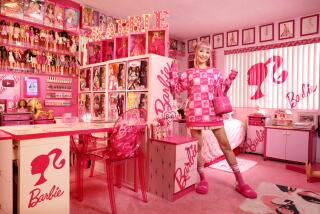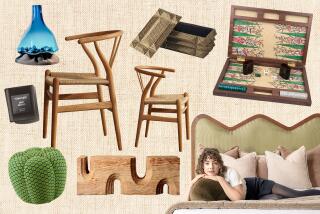Big Bucks in Low-Tech Robot Toys
- Share via
Technology is changing our world, and toys reflect these changes. The toy telephone no longer has a rotary dial and a bell; it is push button and looks cellular. Space toys must keep up and predict the coming technology to intrigue future collectors. Imaginative designers often created toys that predicted the look of the future. The first mass-produced robot toy was Robot Lilliput, which was made in Japan in the 1940s. The 6-inch-high toy now sells for more than $8,500.
In the 1950s and ‘60s, Japanese toy makers made many futuristic toys, especially robots. The idea of a robot that resembles a person has been part of science fiction for many years.
The most famous of these early robot toys were known as the Gang of Five. These five robots, about 15 inches high, were similar. Each one had a lithographed tin body with graphics that suggested machine parts. “Lavender” robot and red “Machine Man” were similar but different colors. “Giant Sonic Train” robot was red and made a train sound. “Radicon” Robot was radio remote-controlled. “Target” robot had a red target on its chest. It reversed direction when the target was hit by a dart. They were all made by Masudaya in Japan in the 1950s.
“Machine Man” is the rarest and most expensive today. It has sold for more than $42,000.
*
Question: My parents’ Queen Anne-style bedroom set was made in the early 1920s. A plaque inside one of the dresser drawers reads, “The Herman Miller Furniture Co., Zeeland, Michigan, The All Walnut Line.” The set includes headboard, mirror, bedside table and two dressers. Can you give me any information on the maker?
*
Answer: The Star Furniture Co. was founded in Zeeland, Mich., in 1905. It was renamed the Michigan Star Furniture Co. in 1919. The company made high-quality reproduction bedroom suites.
In 1923, the president of the company, Dirk Jan De Pree, and his father-in-law, Herman Miller, became majority stockholders, and the company’s name was changed. The company continued making reproductions of historic styles until 1930.
Your parents’ bedroom set was made sometime between 1923 and 1930. During the ‘30s, the Herman Miller Furniture Co. turned to modern designs. By the 1950s, it was famous for its modern home and office furniture. The firm is still in business.
*
Q My turquoise-blue Roseville vase has a design that features a seated nude female. It is 8 inches high.
*
A You have a Roseville “Silhouette” vase. It was first made in 1952.
*
Q Why are there three containers in old inkstands? What were they used for?
*
A The inkstands you refer to date from the 18th and early 19th centuries. They were made of glass, porcelain, silver or some other metal. Some were made of a combination of materials.
Most came with three small jars. One was for ink (a solution of water and colored powder), one for pounce (a fine powder spread on erasures to prevent ink blotches on the roughened paper) and one for lead shot, used to clean the quills. The shot holder sometimes covered a recess for small wafers that were used to seal letters.
Most antique inkstands also had a recessed area to hold rulers, real lead pencils, wax and seals, and a penknife for sharpening quills and erasing ink.
*
Q Among my father’s possessions I found a light-brown silk ribbon picturing Teddy Roosevelt. Also on the ribbon are the words “Exposition St. Louis 1904.” The ribbon is 2 1/2 by 6 3/4 inches, with fringe on each end. I would like to know something about the history and value of this type of ribbon.
*
A Your ribbon is a political souvenir of the 1904 St. Louis World’s Fair. The fair was officially called the Louisiana Purchase International Exposition. It ran from April 30 to Dec. 1, 1904, overlapping Roosevelt’s campaign for reelection.
Roosevelt was pictured on other fair ribbons, with or without his vice-presidential running mate, Charles W. Fairbanks. Your ribbon is valued at $100 to $200.
*
Q My pewter Art Nouveau centerpiece with a glass liner is marked “Bingitzinn” with a diamond holding rays and the initials “GBN.”
*
A “Zinn” is the German word for pewter. Your piece is marked with a trademark used by the Nurnberger Metall-und-Lackierwaren Fabrick. The company was founded by Ignaz and Adolf Bing. The letters GBN stand for Gebruder (brothers) Bing, Nuremberg. The pewter was top-quality. Most of it was made from 1895 to 1906. The company closed in 1932.
For a listing of helpful books and publications, include a self-addressed, stamped (55 cents) envelope to Kovels, Los Angeles Times, King Features Syndicate, 235 E. 45th St., New York, NY 10017.
Current Prices
Figures are recorded from antiques shows, flea markets, sales and auctions throughout the United States. Prices vary because of local economic conditions.
* Kitchen decals by Meyercord, Smiling Chef, 1940s, original envelopes, 8 1/4 x 8 1/2 inches, $20.
* Old Mr. Boston race car, Mario Andretti, No. 9, yellow, $55.
* Nu-Grape Soda playing cards, 1926, $90.
* World War I broadside poster, “Order Your Coal Now Get It Out of Uncle Sam’s Way--He Needs the Railroads for the War,” Fred G. copper lithograph, 1917, 28 x 20 inches, $600.
* Kammer & Reinhardt character toddler doll, bisque head, sleep eyes, open mouth, spring tongue, human-hair wig, five-piece bent-limb body, 24 inches, $750.
* Tom Corbett Space Cadet Atomic pistol, flashlight, blue ray gun, 1952, batteries, Marx, $2,750.
More to Read
Inside the business of entertainment
The Wide Shot brings you news, analysis and insights on everything from streaming wars to production — and what it all means for the future.
You may occasionally receive promotional content from the Los Angeles Times.










